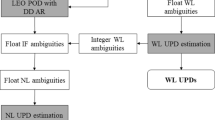Abstract
Ground-based phase wind-up effect (GPWU) is caused by the rotation of receiving antenna. It had been studied and applied in rapidly rotation platforms, such as sounding rocket, guided missile and deep space exploration. In Global Navigation Satellite System high accuracy positioning applications, however, most studies treated it as an error source and focused on eliminating this effect in Precision Point Positioning and Real Time Kinematic (RTK) positioning. The GPWU effect is also sensitive to the rotational status of the antenna, in particular the yaw angle variations. In this paper we explore the feasibility of yaw angle determination of relatively slow rotation platforms based on the GPWU effect. We use the geometry-free carrier phase observations from a RTK base and a moving station receivers to estimate the cumulative yaw angle of the moving platform. Several experiments, including rotating platform tests, vehicle and shipborne tests were carried out. The cumulative errors of rotating platform tests are under 0.38\(^{\circ }\), indicating good long-term accuracy of the GPWU determined yaw angle. But the RMS are in a range of 11.98\(^{\circ }\)and 17.39\(^{\circ }\), indicating the errors, such as multipath effect, are not negligible and should be further investigated. The RMS of vehicle and shipborne tests using a base station of 9–11 km are 24.77\(^{\circ }\) and 23.66\(^{\circ }\). In order to evaluate the influence of the differential ionospheric delay, another vehicle test was carried out using a base station located less than 1 km to the vehicle. The RMS reduces to 15.11\(^{\circ }\), which gains 39.00 % improvement than before, and demonstrates that the differential ionospheric delay even from a few kilometers long baseline still cannot be neglected. These tests validate the feasibility of GPWU for real-time yaw angle determination. Since this method is able to determine the yaw angle with a minimum one satellite, such a unique feature provides potential applications for attitude determination in the environment with poor sky visibility.
















Similar content being viewed by others
References
Abdullah M, Strangeways HJ, Walsh DMA (2003a) Accurate ionospheric error correction for differential GPS. Antenn Propag 1:135–138
Abdullah M, Strangeways HJ, Walsh DMA (2003b) Improved ionospheric error correction for differential GPS. In: Asia-Pacific conference on applied electromagnetics, 2003. APACE 2003, pp 83–87
Banville S, Tang H (2010) Antenna rotation and its effects on kinematic precise point positioning. In: Proceedings of ION GNSS 2010, Portland, OR, pp 2545–2552
Beyerle G (2009) Carrier phase wind-up in GPS reflectometry. GPS Solut 13(3):191–198
Dong D, Wang M, Chen W et al (2016) Mitigation of multipath effect in GNSS short baseline positioning by the multipath hemispherical map. J Geod 90(3):255–262
García-Fernández M, Markgraf M, Montenbruck O (2008) Spin rate estimation of sounding rockets using GPS wind-up. GPS Solut 12(3):155–161
Ge M, Gendt G, Rothacher M, Shi C, Liu J (2008) Resolution of GPS carrier-phase ambiguities in precise point positioning (PPP) with daily observations. J Geod 82(7):389–399
Hernández-Pajares M, Juan JM, Sanz J et al (2000) Application of ionospheric tomography to real-time GPS carrier-phase ambiguities resolution, at scales of 400–1000 km and with high geomagnetic activity. Geophys Res lett 27(13):2009–2012
Hernández-Pajares M, Juan JM, Sanz J et al (2004) Wide area real time kinematics with Galileo and GPS signals. Proceedings of ION GNSS 2004. Long Beach, CA, pp 2541–2554
Hernández-Pajares M, Juan JM, Sanz J et al (2011) The ionosphere: effects, GPS modeling and the benefits for space geodetic techniques. J Geod 85(12):887–907
Kim D, Serrano L, Langley RB (2005) Compensation of the effects of phase wind-up for improving the performance of a GPS RTK-based vehicle navigation system. Proceedings of ION GNSS 2005. Long Beach, CA, pp 346–354
Kim D, Serrano L, Langley R (2006) Phase wind-up analysis: assessing real-time kinematic performance. GPS World 17(9):58–64
Kim D, Langley RB (2007) Ionosphere-nullification technique for long-baseline real-time kinematic applications. Navigation 54(3):227–240
Klobuchar JA (1991) Ionospheric effect on GPS. GPS World 2(4):48–51
Kouba J, Héroux P (2001) Precise point positioning using IGS orbit and clock products. GPS Solut 5(2):12–28
Le AQ, Tiberius CC (2006) Phase wind-up effects in precise point positioning with kinematic platforms. In: Proceeding of ESA/NAVITEC’2006 conference, Noordwijk, The Netherlands
Marini JW (1972) A test of the effect of satellite spin on two-way doppler range-rate measurements. In: IEEE transactions on aerospace & electronic systems AES-8(3):269–272
Montenbruck O, Markgraf M, Jung W et al (2002) GPS based prediction of the instantaneous impact point for sounding rockets. Aerosp Sci Technol 6(2):283–294
Orús R, Hernández-Pajares M, Juan JM, Sanz J (2003) Ionospheric effects on precise navigation at regional and continental scales over Europe. In: ISPRS International workshop, Castelldefels, Spain
Stankov SM, Warnant R et al (2009) Trans-ionospheric GPS signal delay gradients observed over mid-latitude Europe during the geomagnetic storms of October-November 2003. Adv Space Res 43(9):1314–1324
Tetewsky AK, Mullen FE (1997) Carrier phase wrap-up induced by rotating GPS antennas. GPS World 8(2):51–57
Wu JT, Wu SC, Hajj GA, Bertiger WI, Lichten SM (1993) Effects of antenna orientation on GPS carrier phase. Manuscr Geod 18(2):91–98
Zhou F, Dong D, Chen W, Cai M (2016) Isolating fractional phase delays in single differences with common receiver clock. GPS Solut (submitted)
Acknowledgments
This work was sponsored by National Natural Science Foundation of China (Nos. 61372086, 41201380, 11373017), the Science and Technology Commission of Shanghai (Nos. 13511500300, 15511101602), and Open Research Funding Program of KLGIS (No. KLGIS2014A02). We are very grateful to the editor Claudio Brunini and anonymous reviewers for their constructive comments and suggestions.
Author information
Authors and Affiliations
Corresponding author
Rights and permissions
About this article
Cite this article
Cai, M., Chen, W., Dong, D. et al. Ground-based phase wind-up and its application in yaw angle determination. J Geod 90, 757–772 (2016). https://doi.org/10.1007/s00190-016-0908-7
Received:
Accepted:
Published:
Issue Date:
DOI: https://doi.org/10.1007/s00190-016-0908-7




